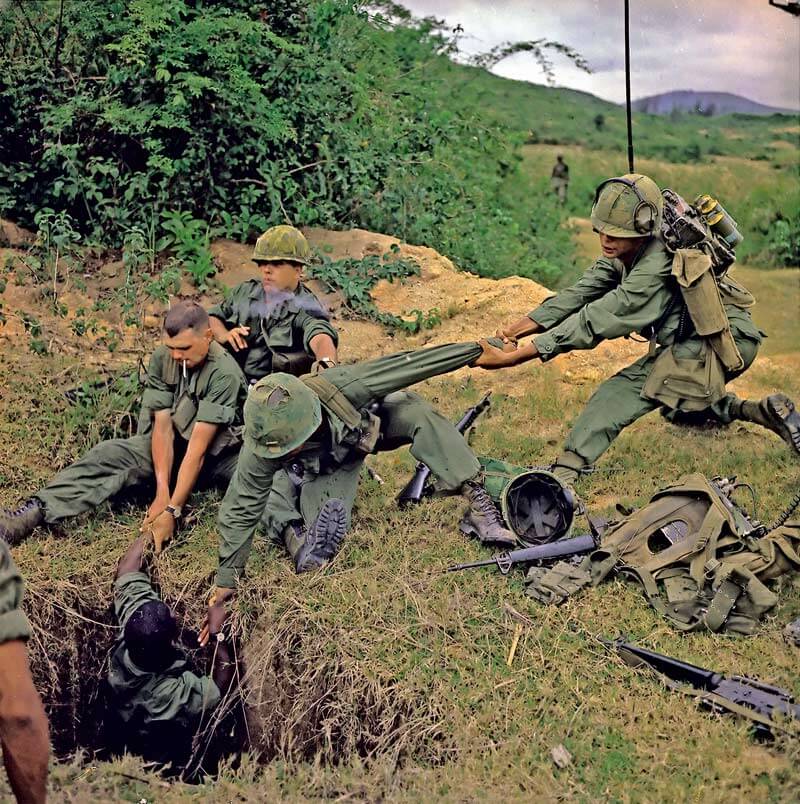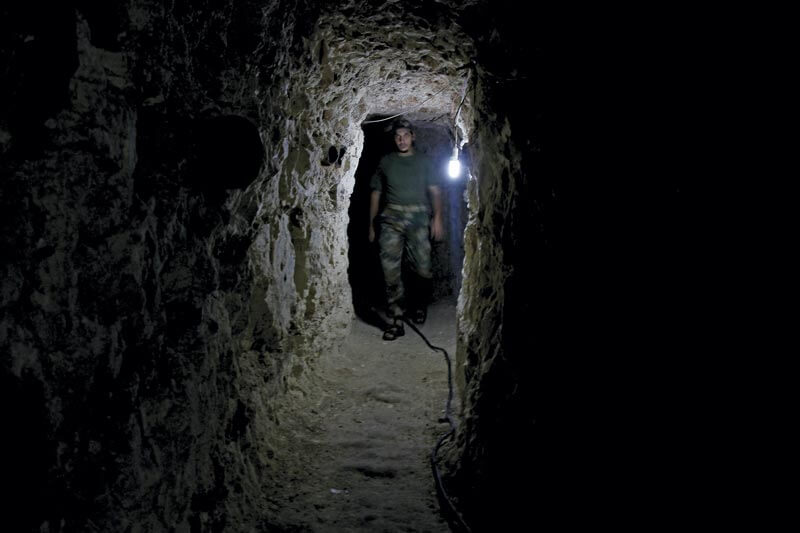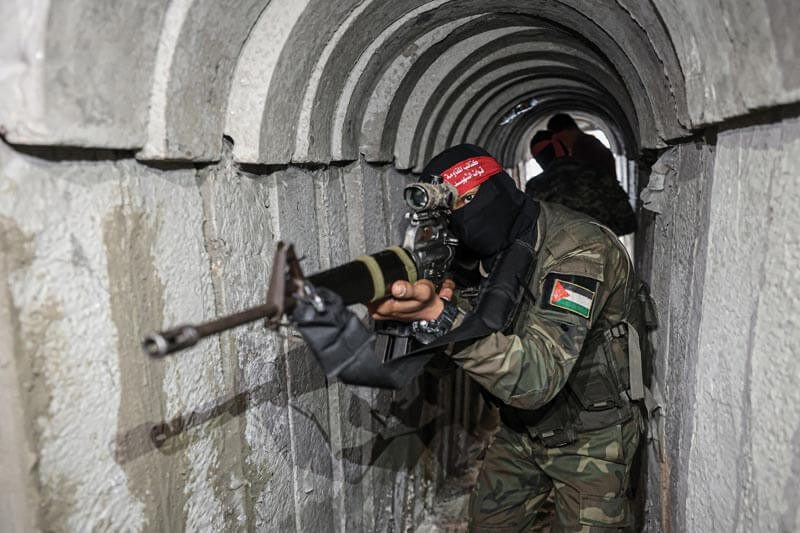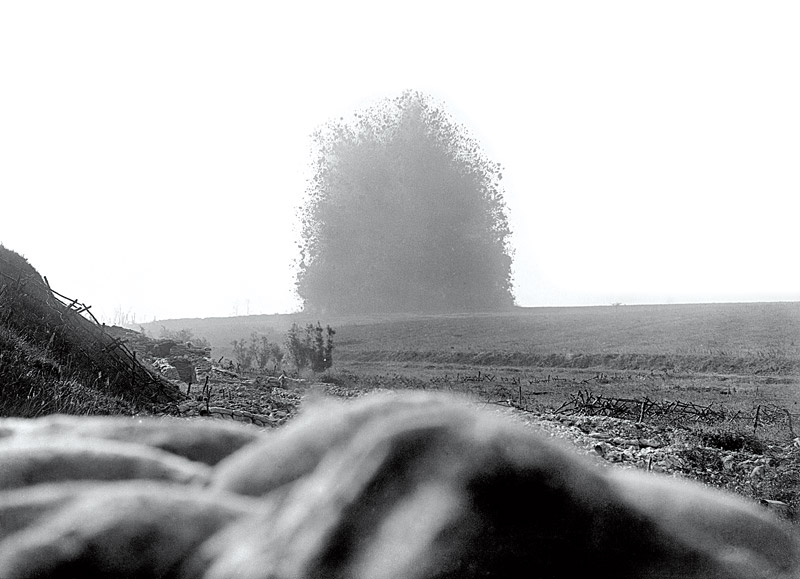
An American “tunnel rat” of Troop B, 1st Reconnaissance Squadron, 9th Cavalry, 1st Cavalry Division (Airmobile), is lowered into a Viet Cong tunnel on April 24, 1967. [SSG Howard C. Breedlove/U.S. National Archive/530613]
For all the advances in humankind’s abilities to wage war, one particular tactic has bedevilled military strategists from ancient times to this day: tunnels.
Tunnels have figured in battles for millennia, from ancient Egypt through the ages of Macedonian and Roman conquest, two world wars, the Vietnam War and onward.
They’ve provided cover, storage and surprise; overcome (or undermined) obstacles, optimized the strength of modest forces and maximized their hitting power. They remain hard to detect and difficult for anyone but their occupants to navigate.
Ancient Egyptians tunnelled beneath city walls; Assyrians were employing specialized engineering troops as early as 850 BC.
In his Histories, the Greek historian Polybius describes mining and counter-mining during the Roman siege in 338 BC at the ancient Greek city of Ambracia, where its Aetolian defenders’ “gallant resistance” compelled the attacking forces to resort to mines and tunnels. This, in turn, brought what were, for their time, remarkable countermeasures.
“For a considerable number of days the besieged did not discover them carrying the earth away through the shaft,” wrote Polybius. “But when the heap of earth thus brought out became too high to be concealed from those inside the city, the commanders of the besieged garrison set to work vigorously digging a trench inside, parallel to the wall and to the stoa which faced the towers.
“When the trench was made to the required depth, they next placed in a row along the side of the trench nearest the wall a number of brazen vessels made very thin; and, as they walked along the bottom of the trench past these, they listened for the noise of the digging outside. Having marked the spot indicated by any of these brazen vessels, which were extraordinarily sensitive and vibrated to the sound outside, they began digging from within, at right angles to the trench, another tunnel leading under the wall, so calculated as to exactly hit the enemy’s tunnel.
“This was soon accomplished, for the Romans had not only brought their mine up to the wall, but had under-pinned a considerable length of it on either side of their mine; and thus the two parties found themselves face to face.”
The Aetolians then released smoke from burning feathers and charcoal, essentially unleashing an early form of chemical warfare.

A Syrian soldier walks a tunnel during a battle with Assad regime forces in Aleppo, Syria, on Aug. 20, 2015. [Mustafa Sultan/Anadolu Agency/Getty Images]
“The tunnel war is one of the most important and most dangerous military tactics in the face of the Israeli army.”
Despite the development of daunting countermeasures, however, tunnels became such an effective tactic that, early on, the very threat of them could inspire fear and capitulation.
Philip V of Macedon discovered the ground was too rocky and hard for mining during his siege at the fortified town of Prinassos in 201 BC. So, he ordered his soldiers to collect earth from elsewhere under cover of night and throw it all down at a fake tunnel entrance, suggesting the Macedonians were nearing completion of a tunnel system. When Philip then falsely declared that his army had undermined large parts of the town walls, its citizens promptly surrendered.
In the Middle East, archeologists recently uncovered a vast tunnel system under northern Israel believed to have been used by Jewish rebels fighting Roman occupation 2,000 years ago.
Indeed, tunnels are an age-old tool in the region where, during the Syrian Civil War in Aleppo in March 2015, rebels detonated explosives beneath the headquarters of the Syrian Air Force Intelligence Directorate, killing dozens.
Mining became standard in siege warfare and, by the 17th century, architects were including complex counter-mining measures into their geometric fortifications.
Ever more powerful artillery rendered sieges a shrinking element of warfare until new tunnelling tactics evolved during the Russo-Japanese War of 1904-05.
During the largely stagnant warfare on the First World War’s Western Front, sappers from both sides—Canadian miners among them—began tunnelling under enemy trenches, planting massive explosives beneath opposing armies, and literally blowing them to bits. The terrifying prospect of an undetected enemy suddenly and decisively taking out an entire front-line trench works and its occupants, without ever showing their faces, proved a formidable psychological weapon as well as a practical one.
On the Pacific island of Iwo Jima, a key stepping stone in the Allied march north during the Second World War, Japanese troops dug a network of tunnels and caves from which they mounted a suicidal defence that exacted a mighty price on the U.S. Marine Corps.
Two decades later, in the Củ Chi District of Saigon (now Ho Chi Minh City), Viet Cong guerillas operated incognito from a vast tunnel network, mounting major operations that plagued American forces for much of the Vietnam War, including the pivotal Tết Offensive of 1968.
Today, tunnels figure infamously in the Hamas-governed Gaza Strip.
In the Palestinian enclave, the loose, easily dug subsoil is the stuff of legend. Its tunnels have confounded armies since Alexander the Great’s siege in 332 BC to Israel’s current offensive against Hamas militants.
As Jean-Pierre Filiu writes in his book, Gaza: A History, Alexander expected a quick victory on the road to Egypt when he set out to take the fortified city on the Mediterranean Sea. It wasn’t to be. Instead, his Macedonian army was forced into what Filiu describes as 100 days of “fruitless attacks and tunneling,” the latter by both the defending Persians and his invading army.
The Gazan commander Batis had known Alexander was coming. He prepared, shoring up fortifications and building an extensive tunnel network. It took Alexander four attempts to overcome his enemy, and the Macedonian commander was wounded in the process.
Batis’ steadfast defence, and refusal to kneel before his ultimate conqueror, so infuriated Alexander that the usually compassionate victor ordered the men of Gaza killed, its women and children sold into slavery, and Batis dragged to death behind his chariot.
Gaza’s tunnels have been infuriating prospective conquerors ever since. Ottoman Turks constructed tunnels during the First World War as they tried unsuccessfully to hold onto what had been for centuries a strategic link between Persia and Egypt.
The Gazan tunnel network expanded after Israel’s statehood in 1948, particularly once Hamas took power in the enclave in 2007.
Known as the Gaza metro, estimates of the size and scope of the tunnels vary. Daniel Rubenstein, former director of the U.S. State Department’s Office of Israel and Palestinian Affairs, has written that Israel discovered 100 kilometres of underground passages during the 2014 Gaza War, a third of them beneath Israeli territory.
Yaniv Kubovich, a journalist with the Israeli newspaper Haaretz, reported in 2021 that Hamas had since constructed “hundreds of kilometers of tunnels the length and breadth of the Gaza Strip.” Senior Iranian officials, who were involved in the project, have estimated the network at 400 to more than 500 kilometres long.
The labyrinth is used to smuggle goods and people in and out of the territory, while Hamas and other militant groups use it for a variety of purposes, including: to store weapons; gather and move underground; communicate, train and launch attacks from it; transport hostages through it; and retreat undetected by Israeli or Egyptian authorities.
“Most tunnels have several access points and routes, starting in several homes or in chicken coops, joining together into a main route, and then branching off again into several separate passages leading into buildings on the other side,” architect Eyal Weizman wrote in his book, Hollow Land: Israel’s Architecture of Occupation.

Fighters from the Democratic Front for the Liberation of Palestine press forward through a tunnel in the southern Gaza Strip on May 19, 2023.[Said Khatib/AFP/Getty Images]
Israeli defence officials estimated that in 2014, Hamas spent US$30 million-$90 million and poured 600,000 tonnes of concrete in building three dozen tunnels, some of them costing as much $3 million apiece.
Workers laboured 8-12 hours a day, earning US$150-$300 a month running jackhammers and digging down 18-25 metres advancing 4-5 metres a day. The notoriously sandy soil required more durable levels of rooftop clay and reinforced concrete panels that were manufactured in workshops adjacent to each tunnel.
It was dangerous work. Hamas reported that 22 members of its armed wing died in underground mishaps—accidental explosions and passage collapses—in 2017.
Buried deep, the shafts are about two metres high by a metre wide, and have electric lights and fixtures. Some even have tracks for transport. They are sometimes booby-trapped.
Hamas is said to have addressed a host of potential challenges, including possibilities that Israeli forces could gas, flood, or blow up parts of the tunnels.
The passages have been used to launch raids, stage kidnappings and resupply the Palestinian resistance. Hamas terrorists used them during the Oct. 7, 2023, attacks on Israeli border communities in which they killed some 1,200 people, including at least seven Canadians, and wounded more than 2,500 others.
An estimated 250 hostages were taken. Survivors have reported groups were transported and kept in the tunnel network.
Whatever can be said of Israel’s merciless response to the attacks, its defence forces have encountered a significant and complex problem in the Gazan tunnels.
“The tunnel war is one of the most important and most dangerous military tactics in the face of the Israeli army because it features a qualitative and strategic dimension, because of its human and morale effects, and because of its serious threat and unprecedented challenge to the Israeli military machine, which is heavily armed and follows security doctrines involving protection measures and preemption,” Adnan Abu Amer wrote for the Al-Monitor, a Middle East newspaper.
The tactic is to “surprise the enemy and strike it a deadly blow that doesn’t allow a chance for survival or escape or allow him a chance to confront and defend itself.”
Tunnels became such an effective tactic that, early on, the very threat of them could inspire fear and capitulation.
Tunnelling took on new dimensions during the First World War when what was amounting to a protracted stalemate in France and Belgium inspired a rethink of underground warfare.
German pioneers blew the war’s first mine in late 1914. Isolated British efforts soon evolved into the formation of specialized tunnelling companies co-ordinated by John Norton-Griffiths, a millionaire entrepreneur, MP and mining engineer who had been advocating for subsurface tactics since the fighting began.
Norton-Griffiths was authorized to raise a tunnelling company in February 1915, recruiting workers he had employed to extend Manchester’s sewage system. He had recognized that Manchester’s geology was similar to Flanders’ and that his miners could transfer the technique known as “clay kicking” to the front lines.
Norton-Griffiths had his first 18 clay kickers—the term inspired by the way the men worked—enlisted and tunnelling to the enemy within 36 hours.

Palestinians move through a tunnel used for military exercises during a weapons exhibition at a Hamas-run youth summer camp in Gaza City on July 21, 2016. [Mohammed Abed/AFP/Getty Images]
“With his back braced the seated miner would use his legs to push an extremely sharp ‘grafting tool’ into the clay,” explained Engineers at War, a website exploring all things related to combat engineering.
“Working from the bottom up the kicker would work 9 inches before fixing a set of timber, a bagger would bag up the spoil and a trammer loaded a tram taking the spoil to the surface. The process was almost silent and very fast.”
Four times faster than traditional mining methods in the firm clay of the Western Front, in fact. To maintain silence, no nails or screws were used to hold supporting timbers together; they relied on the natural swelling of the clay to keep them in place. The process was unknown to the Germans.
Tunnelling capabilities rapidly expanded. On Sept. 10, 1915, the British government sent appeals for tunnelling companies to Canada, South Africa, Australia and New Zealand.
The Canadian Military Engineers raised four tunnelling companies; three served at the front with British formations under the Controller of Mines at General Headquarters. One of the units was formed from men on the battlefield; the two other front-line companies trained in Canada before shipping out.
Formed in Eastern Canada, No. 1 Tunnelling Company moved into the Ypres salient for further instruction in early 1916. By March, it was relieving the British 182nd Tunnelling Company near Armentières, then moved to The Bluff near St. Eloi in Belgium.
Mining operations peaked in 1916 when some 30 Allied tunnelling companies and 30,000-40,000 men were waging underground warfare, their tunnels protecting 50 of the 129 kilometres of British-held front line. Some 1,500 mines were blown in 1916 alone.
In the chalky soil of the Somme, Norton-Griffiths turned to coal-mining techniques. He was allowed to bring in overaged recruits, whose experience would prove vital.
“Digging proceeded with pick and some mechanisation but many tunnel galleries and mine chambers still had to be completed by hand, cutting the chalk with bayonets to limit noise,” said the engineers’ site.

Soldier/artist Ted Zuber depicts Canadian troops and Korean labourers in a tunnel on the Korean peninsula on New Year’s Eve 1952.[Ted Zuber/CWM/19890328-007]
“In this way extensive systems progressed along and across the front lines; spearheading an enormous logistical effort to supply timber, explosives and other equipment whilst ensuring that spoil and any other sign of mining remained unobserved.”
British combat engineers blew up 19 mines under German lines on the Battle of the Somme’s first day, destroying fortifications and killing hundreds of German troops. But the tactic failed to secure the objectives British commanders had hoped for.
In fact, the craters they created became traps for Allied soldiers who poured into them only to become easy prey for German artillery and machine-gunners.
Tunnelling companies of Royal Engineers, many of them Welsh and north English coal miners, had dug passages up to 17 metres down and almost a kilometre long, penetrating deep under key German positions.
In some areas they dug saps, or covered trenches, from the British front lines into no man’s land in efforts to shorten the attackers’ exposure to enemy fire once they launched their assaults.
Silence and secrecy were paramount. Both sides maintained underground listening posts to monitor enemy activity and progress.
“At first relatively rudimentary methods such as water in a glass and augers were used,” said the engineers’ site, “but by 1915 the introduction of geophones was enabling much more accuracy. Using these, tunnelling could be heard in clay from 100m and in chalk from a 240m distance.
“Establishing quiet relied fundamentally on discipline and attention to detail. British miners wore plimsolls underground, Germans remained in their hobnailed boots; British trucks and trams ran on rails screwed into place, German rails were nailed and by 1916 all British mine trolleys had self-oiling bearings.”
Nevertheless, British Captain Stanley Bullock of the 179th Tunnelling Company said his crews could hear German miners working toward them, creating the prospect of pre-emptive explosions or subterranean combat. The Brits finished a small chamber in which to plant explosives just before the Germans stopped their underground advance.
“I used to hate going to listen in that chamber more than any other place in the mine,” wrote Bullock. “Half an hour, sometimes once, sometimes three times a day, in deadly silence with the geophone to your ears, wondering whether the sound you heard was the Boche working silently or your own heart beating.
“God knows how we kept our nerves and judgment. After the Somme attack when we surveyed the German mines and connected up to our own system…we found that we were five feet apart.”
The charges were massive: some 25,000 kilograms of explosive at the site known as Lochnagar near La Boisselle, 18,000 kilograms each at H3 (Hawthorn Ridge) near Beaumont-Hamel and Y Sap in La Boisselle and, in three large mines opposite Fricourt: 11,000 kilograms at G15, 6,800 kilograms at G19 and 4,000 kilograms at G3.
There were others too, including lighter charges in shallower mines designed to remove smaller German positions such as machine-gun posts.
When they were triggered on July 1, 1916, the Lochnagar and Hawthorn Ridge mines were the largest ever detonated. They were deemed at the time to be the loudest artificial noises in history, reportedly heard as far away as London.
“There was an ear-splitting roar, drowning all the guns, flinging the machine sideways in the repercussing air. The earthly column rose, higher and higher.”
Fighter ace Cecil Lewis’s aircraft was hit by lumps of mud from the explosions at La Boisselle. “We were over Thiepval and turned south to watch the mines,” wrote Lewis. “As we sailed down above all, came the final moment…the earth heaved and flashed, a tremendous and magnificent column rose up into the sky.
“There was an ear-splitting roar, drowning all the guns, flinging the machine sideways in the repercussing air. The earthly column rose, higher and higher to almost four thousand feet. There it hung, or seemed to hang, for a moment in the air, like a silhouette of some great cypress tree, then fell away in a widening cone of dust and debris. A moment later came the second mine. Again the roar, the upflung machine, the strange gaunt silhouette invading the sky. Then the dust cleared and we saw the two white eyes of the craters. The barrage had lifted to the second-line trenches, the infantry were over the top, the attack had begun.”
The officer in charge detonated the Kasino Point mine late when he saw that British troops had left their trenches and begun their advance. Instead of exploding upward, it sent debris outward over a wide area, obliterating several German machine-gun nests, but also causing casualties among at least four British battalions.
“I looked left to see if my men were keeping a straight line,” said Lance-Corporal E.J. Fisher of the 10th Essex Regiment. “I saw a sight I shall never forget. A giant fountain, rising from our line of men, about 100 yards from me.
“Still on the move I stared at this, not realizing what it was. It rose, a great column nearly as high as Nelson’s Column, then slowly toppled over. Before I could think, I saw huge slabs of earth and chalk thudding down, some with flames attached, onto the troops as they advanced.”
Planners ultimately decided the negatives of mining the Somme outweighed the positives, and opted against offensive mining in the Canadian attack on Vimy Ridge the following April.

Sappers blow a mine beneath the German field fortification on Hawthorn Ridge Redoubt during the WW I Battle of the Somme on July 1, 1916. [IWM/Q754/Wikimedia]
The war’s most successful mining operation took place in 1917 during the Messines Ridge offensive on the Ypres salient, where 6,000 sappers and attached infantry prepared 19 mines and distributed nearly 450 tonnes of explosives across a 16-kilometre front.
Canadian tunnelling companies blew five of the mines during the battle in which engineers detonated all 19 at 3:10 a.m. on June 7, 1917, just before nine divisions from Britain, Ireland, Australia and New Zealand assaulted German positions on the ridge.
“The [mining] effort was enormous, relying on successful dispersals of tons of spoil, accurate surveying of targeted German positions and the constant husbandry of many mines which had been laid and tamped over a year in advance,” said the engineers’ site.
“Time and geology combined to allow an extensive system which, when blown, destroyed an enormous area of ground and is thought to have instantly killed 10,000 Germans. The remaining defenders were profoundly disorientated and incapable of mounting any resistance to the British attack.”
Even some British troops amassed on the Allied line were concussed.
Messines essentially marked the end of large-scale offensive mining operations. Tunnelling companies were instead increasingly used to construct enormous subterranean systems of accommodation, headquarters, dressing stations and subways.
Nearly a century later, archeologists uncovered the labyrinth of tunnels at La Boisselle, finding poems and soldiers’ signatures etched into the walls along with hundreds of artifacts, including ammunition and discarded food tins.
“It is such an amazing piece of history and it’s so fresh,” genealogist Glen Phillips told the BBC in 2014. “The signatures have been there for nearly 100 years and because the tunnels have been sealed up, they are as fresh as the day they were made…like doodles on a notebook.”

Artist David Bomberg depicts Canadian engineers building a tunnel near St. Eloi, Belgium, in 1918.[David Bomberg/IWM/ART2708/Wikimedia]
Two of Canada’s three mining companies were disbanded in the summer of 1918 and their 1,100 tunnellers redistributed throughout Canadian engineer battalions.
During the war’s final Hundred Days Offensive in 1918, Allied sappers—including the last remaining Canadian mining company, the 3rd—removed more than 1,100 tonnes of explosives from German mines and booby traps.
It was during this final push with the 4th Canadian Division to prevent the demolition of bridges on the Canal de l’Escaut, northeast of Cambrai, in which Captain Coulson Norman Mitchell, a 28-year-old combat engineer from Winnipeg, earned a Victoria Cross.
On the night of Oct. 8-9, Mitchell led a small party ahead of the first wave of infantry to examine the canal bridges and try to keep them intact.
“On reaching the canal he found the bridge already blown up,” said his VC citation. “Under a heavy barrage he crossed to the next bridge, where he cut a number of ‘lead’ wires. Then in total darkness, and unaware of the position or strength of the enemy at the bridgehead, he dashed across the main bridge over the canal.
“This bridge was found to be heavily charged for demolition, and whilst Capt. Mitchell, assisted by his N.C.O., was cutting the wires, the enemy attempted to rush the bridge in order to blow the charges, whereupon he at once dashed to the assistance of his sentry, who had been wounded, killed three of the enemy, captured 12, and maintained the bridgehead until reinforced.”
Mitchell continued cutting wires and removing charges, all while under heavy fire and the lingering threat that the explosives could be triggered at any moment.
“It was entirely due to his valour and decisive action that this important bridge across the canal was saved from destruction.”
He was the only Canadian combat engineer to receive a VC for First World War actions.
Advertisement





















